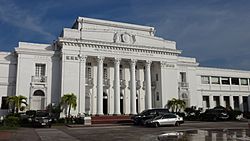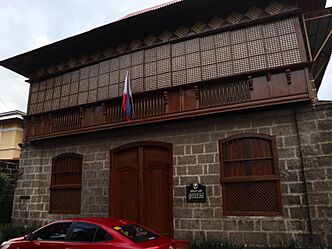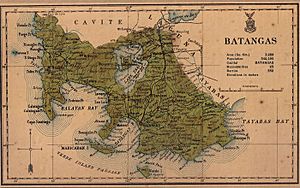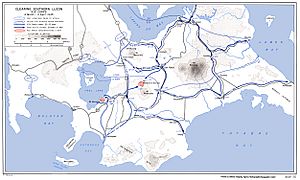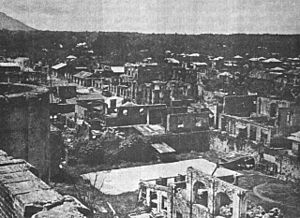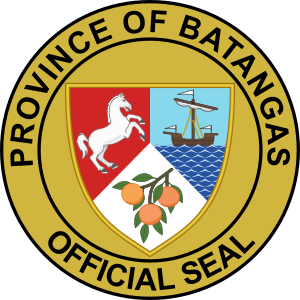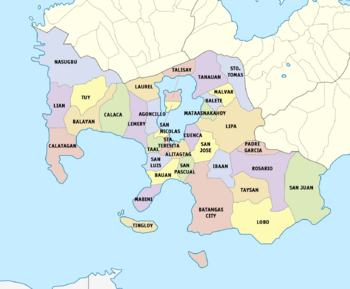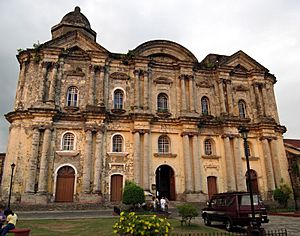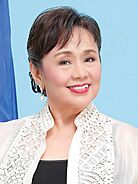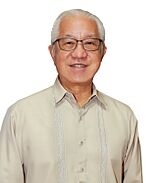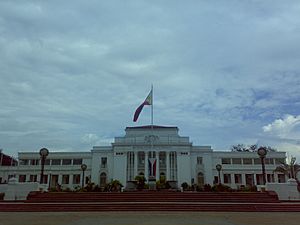Batangas facts for kids
Quick facts for kids
Batangas
|
|||
|---|---|---|---|
|
From left-to-right, top-to-bottom: Batangas Provincial Capitol; Taal Volcano; Taal Basilica; Agoncillo–Mariño House; Malabrigo Point Lighthouse; view from Mount Batulao
|
|||
|
|||
Nicknames:
|
|||
| Motto(s):
"Rich Batangas!"
|
|||
| Anthem: Himno ng Batangan (Batangas Hymn) | |||
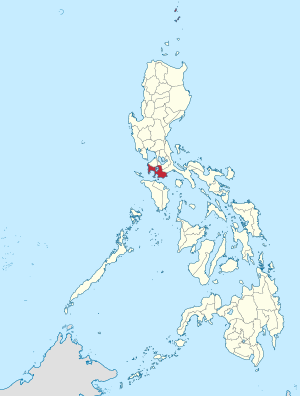
Location in the Philippines
|
|||
|
OpenStreetMap
|
|||
| Country | Philippines | ||
| Region | Calabarzon | ||
| Founded | December 8, 1581 | ||
| Capital | Batangas City | ||
| Largest city | Lipa | ||
| Government | |||
| • Type | Sangguniang Panlalawigan | ||
| Area | |||
| • Total | 3,119.75 km2 (1,204.54 sq mi) | ||
| Area rank | 44th out of 81 | ||
| Highest elevation
(Mount Makiling)
|
1,090 m (3,580 ft) | ||
| Population
(2024 census)
|
|||
| • Total | 2,994,795 | ||
| • Rank | 7th out of 81 | ||
| • Density | 959.9471/km2 (2,486.252/sq mi) | ||
| • Density rank | 6th out of 81 | ||
| Demonym(s) |
|
||
| Divisions | |||
| • Independent cities | 0 | ||
| • Component cities |
5
Batangas City
Calaca Lipa Santo Tomas Tanauan |
||
| • Municipalities |
29
Agoncillo
Alitagtag Balayan Balete Bauan Calatagan Cuenca Ibaan Laurel Lemery Lian Lobo Mabini Malvar Mataasnakahoy Nasugbu Padre Garcia Rosario San Jose San Juan San Luis San Nicolas San Pascual Santa Teresita Taal Talisay Taysan Tingloy Tuy |
||
| • Barangays | 1,078 | ||
| • Districts | Legislative districts of Batangas | ||
| Demographics | |||
| • Ethnic groups |
|
||
| Time zone | UTC+8 (PHT) | ||
| IDD : area code | +63 (0)43 | ||
| ISO 3166 code | PH-BTG | ||
| Spoken languages |
|
||
| Patron Saint | Our Lady of Caysasay | ||
Batangas, officially known as the Province of Batangas, is a province in the Philippines. It is located in the southwestern part of Luzon island, within the Calabarzon region. As of the 2024 census, nearly 3 million people live here, making it one of the most populated provinces in the country.
The capital city of Batangas is Batangas City. The province shares borders with Cavite and Laguna to the north, and Quezon to the east. To the south, across the Verde Island Passages, is the island of Mindoro. The South China Sea lies to the west. Batangas is sometimes called Kumintáng, its old name.
Batangas is known as one of the richest provinces in the Philippines. In 2020, it was the second richest province for two years in a row. Its government had assets worth over ₱25.2 billion, the most in the Calabarzon region and all of Luzon.
This province is a very popular place for tourists, especially those from nearby Metro Manila. It is home to the famous Taal Volcano, one of the world's "Decade Volcanoes." The nearby town of Taal has many old houses, churches, and buildings from the 1800s. Batangas also has beautiful beaches and diving spots. These include Anilao in Mabini, Sombrero Island in Tingloy, and Laiya in San Juan. All the waters around Batangas are part of the Verde Island Passage, which is a global hotspot for marine life.
The Batangas International Port in Batangas City is the second largest international seaport in the Philippines. It is a key area for industry and business in the Calabarzon region. Lipa City is now the most populated city in the province.
Understanding the Name Batangas
The name Batangas comes from the word batangan. This word has two meanings. It can mean a type of log found in the Calumpang River. It can also mean the rafts used for fishing in Taal Lake.
The way people speak Tagalog in Batangas is very similar to the old Tagalog language. This is why some experts call Batangas the heart of the Tagalog language. The strong Tagalog culture is still very clear today. Batangas also has a high literacy rate, meaning most people can read and write. About 96.5% of people are literate.
How Batangas Got Its Name: A Look Back
The province was first called Kumintáng. Its main town was Taal. Later, the center moved to Balayan, which was a very busy town. But a huge eruption of Taal Volcano in 1754 destroyed much of Taal. Because of this, people moved to Bonbon (now Taal). The name Bonbon eventually covered the whole area of the modern province.
A Glimpse into Batangas' Past
Ancient Times in Batangas
Long ago, many people lived along the coasts and rivers of what is now Batangas. Villages were built along the Pansipit River, which flows from Bombon Lake (now Taal Lake). This area was important for the Maritime Jade Road. This was a huge trade network for jade that lasted for about 3,000 years. People traded with other groups in the Philippines, and with people from Borneo, China, and Japan.
Archaeological finds show that the early Tagalogs had complex societies. They traded with Indianized states and China. This is seen in words borrowed from Sanskrit and old pottery from China, Vietnam, and Thailand. A Buddhist statue found in Calatagan looks like Buddha images from Siam, India, and Nepal.
In 1941, two stone figures were found in Calatagan. One was lost during World War II. Later, in 1959, a grave was found in Punta Buaya. It contained 12 human remains with carved brain coral behind their heads. This site was called Likha, meaning "create." Pottery, jewelry, and metal objects from the 14th century were also found. This shows that the people living there traded with people from far away, like China.
The discovery of dining items buried with the dead suggests that ancient Batangueños believed in life after death. They had similar customs to other Asian cultures, burying items with the deceased. The early Batangueños were generally peaceful. They used simple weapons like bows and arrows (bakyang), spears (bangkaw), and a type of knife (suwan). They were also very superstitious. They used agimat (amulets) and believed that nature's forces were signs from higher beings.
Some historians believe Batangas was the true center of the Tagalog people. They identified it as Ma-yi, a place mentioned in old Chinese records. These records say Ma-yi included areas like Cavite, Laguna, Rizal, and Quezon.
An American archaeologist, Henry Otley Beyer, studied the early Batangueños. He found many jade artifacts in caves in the province. He even named a period of Philippine history the Batangas Period because of all the jade found there. The jade culture was present in Batangas from about 800 B.C. to 200 B.C.
Life Before Spanish Rule
Before the Spanish arrived, Batangas had many important settlements. These included Balayan, Bonbon (Taal), and Kumintang. Kumintang was a large area around the Calumpang River in modern Batangas City. Local stories say it was ruled by a brave leader named Gat Pulintan. He resisted the Spanish and refused to become Christian.
Spanish Colonial Period
In 1570, Spanish explorers Martin de Goiti and Juan de Salcedo explored the Batangas coast. They found a settlement at the mouth of the Pansipit River. In 1572, the town of Taal was founded. Its church and convent were built later.
The Spanish officially founded the Province of Bonbon in 1578. It was named after the local Muslim people. In 1581, the Spanish government changed Bonbon Province to Balayan Province. This new province included parts of present-day Batangas, Mindoro, Marinduque, and parts of Laguna, Quezon, and Camarines. After the big Taal Volcano eruption in 1754, the old town of Taal (now San Nicolas) was buried. The capital was moved to Batangas (now a city) to avoid more eruptions. It has been there ever since.
The Franciscan missionaries came to Taal in the same years. Taal became the first Spanish settlement in Batangas. In 1572, the Augustinians founded Taal in the area of Wawa (now San Nicolas). They began teaching Christianity in Balayan and other settlements around Bombon Lake. The Augustinians stayed until the Philippine Revolution. They were the first missionaries in the area. They learned the local language and wrote prayer books and the first Tagalog grammar.
Important churches were built over the years:
- 1572: Taal Parish
- 1581: Batangas Parish
- 1596: Bauan Parish
- 1605: Lipa Parish
- 1774: Balayan Parish
- By the late 1700s, Batangas had many Filipino and Spanish families.
- 1852: Nasugbu Parish
- 1868: Lemery Parish
The town of Nasugbu became an important trading center during Spanish rule. It was also the site of the first recorded battle between two European forces in Asia. This happened at Fortune Island in Nasugbu. Later, a sunken Spanish ship was found there. It contained items from the Manila-Acapulco Galleon Trade.
Batangas was one of the first eight Philippine provinces to fight against Spain. Spanish Governor-General Ramon Blanco declared martial law in Batangas on August 30, 1896. This is why the Philippine Flag, made by Marcela Agoncillo from Batangas, has a sun with eight rays. These rays represent these eight provinces.
American Colonial Era
When the Americans took over, they banned the Philippine flag. Revolutionaries in Batangas used plays to spread their message. In one event, a play called Tanikalang Ginto was performed. Everyone involved, including the audience, was arrested. The play was then banned across the country.
General Miguel Malvar was the last Filipino general to surrender to the United States during the Philippine–American War.
Japanese Occupation During World War II
After the attack on Pearl Harbor in 1941, Japan attacked the Philippines. Batangas Airport in Batangas City was destroyed by bombings. Batangas was also a site of fierce air battles. On December 12, 1941, six Filipino fighter planes, led by Capt. Jesús Villamor, fought 54 Japanese bombers and fighters. Captain Villamor's group won, but Lt. César Basa was killed.
When Gen. Douglas MacArthur ordered American and Filipino forces to retreat to Bataan in 1942, Batangas was left under Japanese control. During this time, the Imperial Japanese Army committed many terrible acts against civilians. Hundreds of people were killed in towns like Bauan, Taal, and Cuenca.
Liberation of Batangas
The liberation of Batangas began on January 31, 1945. American troops from the 11th Airborne Division landed in Nasugbu, Batangas. However, their main goal was to capture Manila. By March 3, Manila was secured.
The liberation of Batangas itself started in March 1945. The 11th Airborne Division and the 158th Regimental Combat Team (RCT) were involved. The 158th RCT secured the coast and towns like Balayan and Batangas City. The 11th Airborne attacked Japanese defenses north of Taal Lake. By March 11, the 158th RCT reached Batangas City. They fought to capture the Calumpang Peninsula near Mabini. This area was finally liberated on March 16.
After this, the 158th RCT moved north to fight the Japanese at Mt. Maculot in Cuenca. Heavy fighting continued until April 17. Mt. Maculot was finally captured on April 21.
The last major battle to free the Lipa area began on March 24. Lipa was captured by the 1st Cavalry on March 29. The Japanese forces were finally defeated at Mount Malepunyo on May 2.
During these battles, Filipino guerrilla fighters helped a lot. They provided information and helped the American and Filipino troops advance. The fighting in Batangas resulted in many casualties for the Japanese. By the end of April 1945, Batangas was fully liberated.
Filipino soldiers from the Philippine Commonwealth Army and Philippine Constabulary also fought bravely. They helped liberate Batangas from 1942 to 1945.
Philippine Independence and Beyond
After the war, Gen. Douglas MacArthur landed in Nasugbu to mark the liberation of Luzon. This event is celebrated by the people of Nasugbu every January.
After the Philippines gained independence from the United States, many leaders from Batangas played important roles in the government. These included Felipe Agoncillo, Galicano Apacible, Ramon Diokno, Teodoro Kalaw, Claro M. Recto, and José Laurel, Jr..
During the Japanese Occupation, José Laurel, Sr. from Batangas became the president of the Japanese-backed Second Philippine Republic.
Batangas in Recent History
Batangueños faced challenges during the time of President Ferdinand Marcos. In 1981, Marcos used his power to change 167 hectares of farmland in San Rafael, Calaca, into an industrial area. This allowed the building of the Semirara Calaca power plant, despite concerns about its effects on health and the environment.
Student leaders Ismael Umali, Noel Clarete, and Aurelio Magpantay from Western Philippine Colleges disappeared in March 1984 after a protest. Their bodies were later found in Cavite province.
After Marcos was removed from power in 1986, many Batangueños took important government positions. These included Salvador Laurel, who became Vice President of the Philippines, and Renato Corona, who became Chief Justice of the Supreme Court of the Philippines.
Geography of Batangas
Batangas has mostly flat lands with mountains scattered around. One of these is Mt. Taal, which is one of the world's smallest volcanoes. It is about 600 meters (1,968 feet) high and sits in the middle of Taal Lake. Other important mountains include Mount Macolod (830 m), Mt. Banoy (960 m), and Mt. Batulao (693 m).
Batangas also has several islands. These include Tingloy, Verde Island (Isla Verde), and Fortune Island near Nasugbu.
According to Guinness World Records, Batangas is home to the "largest island in a lake on an island." This is Vulcan Point, located in Crater Lake, which is inside Taal Island, which is in Lake Taal, on the island of Luzon.
Climate in Batangas
Batangas experiences two main types of tropical climates. Most of the province has a tropical savanna climate. This means it has clear dry and wet seasons. Parts of the eastern side have a tropical monsoon climate, where the dry and wet seasons are less distinct. Batangas City, the capital, has a tropical savanna climate but is also affected by the monsoon climate. This results in short dry seasons and longer wet seasons. Typhoons often occur, especially during the southwest monsoon season.
Administrative Divisions
Batangas is made up of 29 municipalities and 5 cities. Nasugbu is the largest municipality by land area, covering over 278.51 square kilometers. San Nicolas is the smallest, with 22.61 square kilometers. Taal is the most crowded, with over 2,066 people per square kilometer. Lobo is the least crowded, with about 230 people per square kilometer.
- † Provincial capital and component city
- ∗ Component city
- Municipality
- Agoncillo
- Alitagtag
- Balayan
- Balete
- Batangas City †
- Bauan
- Calaca ∗
- Calatagan
- Cuenca
- Ibaan
- Laurel
- Lemery
- Lian
- Lipa ∗
- Lobo
- Mabini
- Malvar
- Mataasnakahoy
- Nasugbu
- Padre Garcia
- Rosario
- San Jose
- San Juan
- San Luis
- San Nicolas
- San Pascual
- Santa Teresita
- Santo Tomas ∗
- Taal
- Talisay
- Tanauan ∗
- Taysan
- Tingloy
- Tuy
People and Culture
As of the 2020 census, Batangas had 2,908,494 people. This means there were about 932 people per square kilometer. Most people in Batangas are Tagalogs, who are the original settlers of the province. Other groups include Bicolanos, Visayans, and others from different parts of the Philippines.
Batangas has a high literacy rate of 96.5%. This means most people can read and write. Men have a slightly higher literacy rate (97.1%) than women (95.9%).
Language and Communication
The Tagalog dialect spoken in Batangas is very similar to the old Tagalog language. This is why some call Batangas the "heartland" of the Tagalog language. The strong Tagalog culture is still very clear today. Many educated Batangueños speak a mix of old Tagalog and English words, like modern Filipino.
People from Batangas often add the words eh or ga to the end of their sentences. These words are like the word ba in Filipino. They use them to add emphasis. Sometimes, they even say "ala eh," which doesn't have a direct meaning but is a common saying.
English is widely understood in Batangas. Some older people in towns like Nasugbu, Taal, and Lemery also understand Spanish. Other languages like Bicolano, Kapampangan, and Visayan are spoken by people who have moved to Batangas from other regions.
Religious Beliefs
Most people in Batangas are Roman Catholic. Other religious groups include Iglesia Filipina Independiente, Members Church of God International (MCGI), and Iglesia ni Cristo. There are also followers of Islam, Buddhism, and various Protestant churches.
Catholic Traditions
Batangueños are known for their strong religious practices. They perform rituals like dances (subli) and chants (luwa/lua) to show their faith. During the Lenten season, they recite the Pasyon, which tells the story of Jesus Christ. The first printed version of the pasyon was written by Gaspar Aquino de Belen from Rosario.
In May, people in Bauan and Alitagtag celebrate the feast of the Mahal na Poon ng Santa Cruz (Lord of the Holy Cross). They perform a ritual dance called the Subli. In Taal, they celebrate the feast of Our Lady of Caysasay and San Martin de Tours. This is a two-day event with processions on land and water. Fiestas in other towns usually happen from May to early June.
Mythology and Stories
Scholars say that ancient Batangueños, like other Tagalogs, worshipped a Supreme Creator called Bathala. They also believed in lesser gods like Mayari, the moon goddess, and Apolake, the sun god. They practiced Dambana, which involves sacred places.
In literature, Padre Vicente Garcia became famous for defending José Rizal's novel, Noli Me Tangere. In 2004, Batangas honored Domingo Landicho, a poet from the province, with the Dangal ng Batangas (Pride of Batangas) Award.
Artistic Expressions
Music and Dance
Batangas is believed to be the origin of the kumintang. This was an old war song that later became the kundiman, a type of Filipino love song. Another vocal music form, the awit, also came from the ancient kumintang. The huluna, a lullaby, is popular in some towns like Bauan.
During the Lenten Season, the Pasyon is sung everywhere. This is a Christian story about Jesus Christ. Debates can also be sung in Batangas. The duplo is a sung debate where each line has eight syllables. The karagatan is another sung debate where each line has twelve syllables. Its name, meaning "ocean," comes from its opening lines that compare the debate's difficulty to the ocean's depth.
Batangas is also where the balitao comes from. This is both a vocal and dance music form. Along with the subli, it is the most famous dance from Batangas.
Architecture and Sculptures
Batangas has some of the best-preserved old buildings in the Philippines. This is especially true in the town of Taal.
While not as famous as Paete for carvings, Taal is known for its carved furniture. Altar tables from Taal were sometimes called the "friars' choice." According to scholar Milagros Covarubias-Jamir, furniture from Taal during colonial times was as good as furniture from China. The furniture was so well-made that nails or glue were not used. Batangueños knew how to use hardwoods very well. Because of this, furniture made over a hundred years ago can still be found in old churches and houses today.
Local Cuisine
Batangas is famous for its delicious food. Here are some popular dishes:
- Bulalo: A hearty beef shank soup.
- Lomi Batangas: A thick noodle soup.
- Goto: A savory rice porridge.
- Adobo sa dilaw: Adobo cooked with turmeric, giving it a yellow color.
- Pakalaste: Batangas adobo with coconut milk.
- Longganisang Taal: A local sausage from Taal.
- Tapang Taal: Cured beef from Taal.
- Sinaing na tulingan: Bullet tuna cooked in a special way.
- Taghilaw: A dish made from pork or beef organs.
- Sinigang na maliputo: Sour soup with maliputo fish.
- Sinunggaok or sampene: Batangas-style blood stew.
- Bagoong Balayan: A fermented fish paste.
- Tinapa ng Lemery: Smoked fish from Lemery.
- Pupor: Batangas-style crispy pork rinds.
- Pancit tostado: Toasted noodles.
- Pancit ni Biko: A unique noodle dish.
- Pancit pula/tikyano: Red noodles.
- Tamales ng Ibaan: A type of steamed rice cake.
- Sumang magkayakap ng Tanauan: Sticky rice cakes.
- Kalamay kapit: A sweet sticky rice dessert.
- Nilupak: Mashed root crops with coconut.
- Kapeng barako: Strong coffee grown in Batangas.
- Tsokolate tablea: Pure chocolate tablets for hot chocolate.
- Panutsa: Hardened brown sugar candy.
- Murkon: Batangas-style meatloaf.
Museums and Historical Sites
- Museo ng Katipunan: Located in Barangay Bulaklakan, Lipa.
- Apolinario Mabini Shrine: Found on Talisay—Tanauan Road, Barangay Talaga, Tanauan, Batangas.
- Marcela Agoncillo Landmark: In Barangay Zone 4, Taal, Batangas.
- Museo ni Miguel Malvar: On Gov. Malvar St, Poblacion 1, Santo Tomas, Batangas.
- Museo ng Batangas at Aklatang Panlalawigan: Includes the Dr. Jose P. Laurel Library, Tanauan, Batangas.
Economy and Products
|
||||
Batangas is a very rich province. In 2020, it was the second richest province in the Philippines. Its provincial government had a record-high ₱25.2 billion in assets. This was the largest amount in the Calabarzon region and all of Luzon.
Famous Products
Batangas is well-known for its butterfly knives, called balisong. Making these knives is an important industry in the province.
Farming and Fishing
Pineapples are also common in Batangas. Not only is the fruit popular, but the leaves are also used to make a silk-like fabric called piña. This fabric is used to make the barong tagalog, the national costume of the Philippines.
Raising livestock is a big industry in Batangas. The term bakang Batangas (Batangas cow) refers to some of the best cattle in the country. Cattle raising is so common that every Saturday, there are cattle auctions in San Juan, Bauan, and Padre Garcia.
Fishing is also very important to the province's economy. While the main tuna industry is in General Santos, Batangas is known for smaller tuna species. Locals have special names for them, like tambakol (bigeye tuna) and tulingan (Pacific bluefin tuna). The wahoo (tanigi) is also an important catch.
Besides the South China Sea, Taal Lake provides freshwater fish. The lake is home to Sardinella tawilis or tawilis, a type of freshwater sardine found only there. Taal Lake also produces farmed Chanos chanos (bangus) and Oreochromis niloticus niloticus (tilapia). It's important to know that bangus and tilapia are not native to the lake and are considered invasive species.
Sugar is another major industry. After Hacienda Luisita, the country's largest sugar producer, was divided, Nasugbu became home to the current largest sugar company, Central Azucarera de Don Pedro. Rice cakes and sweets are also a strong industry.
Some towns near Laguna have a thriving bamboo industry. Many houses and furniture are made from bamboo. Locals say that food cooked in bamboo has a special smell and taste. Labong, or bamboo shoots, is cooked with coconut milk or other ingredients to make a Batangas delicacy.
Industrial Growth
Batangas has five industrial parks registered under the Philippine Economic Zone Authority (PEZA). These parks are located along the STAR Tollway and Jose P. Laurel Highway. The largest is LIMA Technology Center, a 500-hectare area for tech companies in Lipa and Malvar. Another is the First Philippine Industrial Park (FPIP), covering 350 hectares in Santo Tomas and Tanauan. Light Industry and Science Park IV (LISP IV) is a 170-hectare industrial area in Malvar.
Batangas City and nearby towns like San Pascual, Bauan, and Mabini have large industrial activities. These include power generation, oil and gas processing, shipping, and ship repairs.
Government and Leadership
Vilma Santos-Recto
Hermilando Mandanas
Batangas was one of the first provinces established by the Spanish in the Philippines. It was first called Bonbon, named after Taal Lake. In 1534, Batangas became the first organized province in Luzon. Balayan was the capital for 135 years. In 1732, it moved to Taal. After the Great Taal Eruption of 1754, the capital moved to Batangas City in 1889, where it remains today.
Some Philippine historians call Batangas the "Cradle of Noble Heroes." This is because many national heroes and leaders came from here. These include Teodoro M. Kalaw, Apolinario Mabini, Jose Laurel, and Felipe Agoncillo.
Current Officials
The province is led by a Governor and a Vice Governor. There is also a Provincial Board that helps make decisions.
- Governor: Vilma Santos-Recto
- Vice Governor: Hermilando I. Mandanas
The Provincial Board members are:
- 1st District: Anna Coretta R. Santos, Armie Marie I. Bausas
- 2nd District: Maria Reina D. Abu-Reyes, Jently O. Rivera
- 3rd District: Alfredo C. Corona, Rodolfo M. Balba
- 4th District: Marcus Dominic S. Mendoza, Melvin V. Vidal
- 5th District: Emilio Francisco A. Berberabe Jr., Hamilton G. Blanco
- 6th District: Oscar M. Gozos II, Aries Emmanuel D. Mendoza
- ABC: Fernando R. Rocafort
- PCL: Venice D. Manalo
- SK: Voltaire Aedrian P. Pua
Representatives in Congress
Batangas has six districts, each with a representative in the House of Representatives of the Philippines.
- 1st District: Leandro Antonio L. Leviste
- 2nd District: Gerville R. Luistro
- 3rd District: King George Leandro Antonio V. Collantes
- 4th District: Amado Carlos M. Bolilia IV
- 5th District: Beverley Rose A. Dimacuma
- 6th District: Ryan Christian S. Recto
Transportation and Utilities
Getting Around Batangas
The province used to have a railway line, but it stopped working in 1986.
Roads for Travel
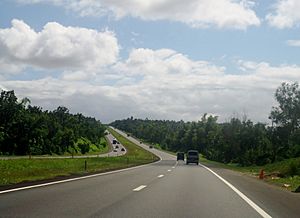
Batangas has about 556 kilometers (345 miles) of national roads, mostly paved. The Southern Tagalog Arterial Road (STAR Tollway), Maharlika Highway, and Jose P. Laurel Highway are the main roads. They connect most of the towns. The provincial government also maintains local roads.
Bus companies like Del Monte Land Transport Bus Company (DLTBCo) operate routes in the Southern Tagalog region. The Cavite–Batangas Expressway (CBEX) is a planned expressway. It will connect Silang, Cavite to Nasugbu. CBEX will also link with the Cavite–Laguna Expressway (CALAEX).
Water Transport
Batangas Port in Batangas City is a major port for ferries. You can take ferries from here to Mindoro, Tablas, Romblon, and other islands. Montenegro Lines is a large passenger shipping company operating from Batangas. The port was expanded in 2008 to handle container ships.
Batangas is a gateway to other islands. It has roll-on/roll-off (RoRo) ferry connections to Mindoro and Visayas. The Western Nautical Highway starts in Batangas and connects to Calapan, Oriental Mindoro. Batangas Port is an important port for both cargo and passenger shipping.
Electricity Supply
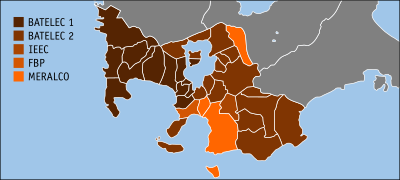 Electricity in Batangas is mostly provided by electric cooperatives. These are Batangas I Electric Cooperative (BATELEC-I) and Batangas II Electric Cooperative (BATELEC-II). BATELEC-I serves western Batangas, including Nasugbu and Taal. BATELEC-II serves eastern Batangas, including Lipa and Tanauan. Some areas like Bauan, Ibaan, and LIMA Technology Center have local utility companies. Santo Tomas, the First Philippine Industrial Park (FPIP), San Pascual, and Batangas City are served by Meralco, an electric company from Metro Manila.
Electricity in Batangas is mostly provided by electric cooperatives. These are Batangas I Electric Cooperative (BATELEC-I) and Batangas II Electric Cooperative (BATELEC-II). BATELEC-I serves western Batangas, including Nasugbu and Taal. BATELEC-II serves eastern Batangas, including Lipa and Tanauan. Some areas like Bauan, Ibaan, and LIMA Technology Center have local utility companies. Santo Tomas, the First Philippine Industrial Park (FPIP), San Pascual, and Batangas City are served by Meralco, an electric company from Metro Manila.
Batangas has three power plants that supply most of Luzon's electricity. These include the Calaca Coal Fired Power Plant in Calaca and the San Lorenzo-Santa Rita-San Gabriel Combined Cycle Power Plant in Batangas City. The Ilijan Power Plant is also in Batangas City. Most power plants in Batangas use fossil fuels like coal and natural gas. This has led to environmental concerns because of their impact on ecosystems. A new power plant planned for Mabacong, Batangas City, is facing opposition from environmental groups and the Roman Catholic Archdiocese of Lipa. They are worried about its effects on residents and the marine life in Verde Island Passage.
Flora and Fauna
The malabayabas, also known as Philippine teak, is a tree found only in Batangas. The province is also home to the kabag (Haplonycteris fischeri), one of the world's smallest fruit bats. In Nasugbu, wild deer still live in remote areas.
In 2006, scientists found that the Coral Triangle has its center in the Isla Verde Passage in Batangas. A study by American marine biologist Kent Carpenter showed that Batangas seas have more than half of the world's coral species. It is also home to dolphins. Sometimes, the world's biggest fish, the whale shark or butanding, can be seen there. The town of San Juan has resident marine turtles or pawikan. Different types of sea turtles, like the Olive ridley sea turtle, leather back sea turtle, and green sea turtle, can still be seen in Nasugbu.
Notable People from Batangas
National Heroes and Patriots
- Apolinario Mabini — A Filipino revolutionary leader.
- Miguel Malvar — A Filipino general during the Philippine Revolution.
- Felipe Agoncillo — A Filipino lawyer who represented the Philippines in peace talks.
- Marcela Agoncillo — The main person who sewed the first official flag of the Philippines.
- Galicano Apacible — A co-founder of La Solidaridad, a newspaper for Filipino reforms.
- Ananias Diokno — A Filipino general during the Philippine Revolution.
- Juan Cailles — A Filipino general during the Philippine-American War.
- Gliceria Marella de Villavicencio — A heroine of the Revolution.
- Clemencia López — A Filipina who fought for women's rights.
- Maria Orosa — A Filipina food scientist and war heroine.
- Teodoro Kalaw — A Filipino scholar and historian.
- Claro M. Recto — A statesman, lawyer, and poet.
Leaders in Politics and Government
- Mark Leviste - Former Vice Governor of Batangas.
- José P. Laurel — President of the Philippines during World War II.
- Salvador Laurel — The 8th Vice President of the Philippines.
- Jose Laurel Jr. — The 9th Speaker of the House of Representatives of the Philippines.
- Manuel Araullo, The 3rd Chief Justice of the Supreme Court.
- Querube Makalintal, The 11th Chief Justice of the Supreme Court.
- Ramon Aquino, The 15th Chief Justice of the Supreme Court.
- Ramón Diokno, An Associate Justice and former senator.
- Cecilia Muñoz-Palma - The first woman Associate Justice of the Supreme Court.
- Angelina Sandoval-Gutierrez — An Associate Justice of the Supreme Court.
- Cancio Garcia — An Associate Justice of the Supreme Court.
- Rosmari Carandang — An Associate Justice of the Supreme Court.
- Antonio de las Alas - Former senator and Secretary of Finance.
- Sotero Laurel — Former senator.
- Ralph Recto — A Senator of the Philippines.
- Vilma Santos – Former House Representative and Governor of Batangas, also a film actress.
- Domingo F. Panganiban — Former Secretary of Agriculture.
- Renato de Villa — Former Chief of Staff of the Armed Forces and Secretary of National Defense.
- Eduardo Ermita — Former Secretary of National Defense and Executive Secretary.
- Leandro Mendoza — Former Secretary of Transportation and Communications.
- Benjamin Diokno — Former Governor of the Bangko Sentral ng Pilipinas and Secretary of Budget.
- Efren L. Abu - Former Chief of Staff of the Armed Forces.
- Noel Clement — Former Chief of Staff of the Armed Forces.
- Rommel Sandoval — A Philippine Army captain who received the Medal of Valor.
Talented Individuals in Arts and Sciences
- Leonor Orosa-Goquingco — A National Artist of the Philippines for Dance.
- Bienvenido Lumbera — A National Artist of the Philippines for Literature.
- Gregorio Y. Zara — A National Scientist for Engineering and Inventions.
- Teodoro Agoncillo — A National Scientist for Philippine History.
- Deogracias Villadolid — A biologist.
- Anastacio Caedo — A Filipino sculptor.
- Lito Mayo — A graphic artist, print-maker, and sculptor.
Religious Figures
- Alfredo Obviar — A Filipino Venerable and Bishop Emeritus of Lucena.
- Vicente García — A Filipino priest and defender of Jose Rizal.
- Armin Luistro, FSC — Former Superior General of the De La Salle Brothers and Secretary of Education.
- Gaudencio Rosales - A Filipino Cardinal and former Archbishop of Manila.
- Ramon Arguelles — A Filipino Roman Catholic Archbishop.
- Reynaldo G. Evangelista - A Filipino Roman Catholic Bishop.
- Marcelino Antonio Maralit - A Filipino Roman Catholic Bishop.
- Fernando Suarez — A Filipino Catholic priest known for faith healing.
Sports, Popular Culture, and Entertainment Stars
- Arsenio Laurel — A champion race car driver.
- Nora Daza — A veteran chef, restaurateur, and TV host.
- Ai-Ai delas Alas — An actress, comedian, and singer.
- Simon Ibarra — An actor.
- Charlie Dizon — An actress and model.
- Ogie Alcasid — A singer-songwriter, TV presenter, and actor.
- TJ Trinidad — An actor, singer, and model.
- Leo Martinez — An actor, comedian, and director.
- Zanjoe Marudo — An actor and model.
- Jade Lopez — A Filipina actress.
- Jason Gainza — An actor and impersonator.
- Joshua Garcia — An actor, model, and endorser.
- Alyssa Valdez — A famous volleyball player.
- Kim Fajardo – A volleyball athlete.
- Jovit Baldivino — A singer and winner of Pilipinas Got Talent.
- Perfecto de Castro — A musician and YouTuber, former guitarist of Rivermaya.
- Francis Reyes — A musician and radio announcer, guitarist of The Dawn.
- Darius Semaña — A musician, lead guitarist of Parokya ni Edgar.
- Mary Loi Yves "Maloi" Ricalde — A musician, main vocalist of BINI.
See also
 In Spanish: Provincia de Batangas para niños
In Spanish: Provincia de Batangas para niños


